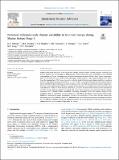Files in this item
Persistent millennial-scale climate variability in Southern Europe during Marine Isotope Stage 6
Item metadata
| dc.contributor.author | Wilson, G.P. | |
| dc.contributor.author | Frogley, M.R. | |
| dc.contributor.author | Hughes, P.D. | |
| dc.contributor.author | Roucoux, K.H. | |
| dc.contributor.author | Margari, V. | |
| dc.contributor.author | Jones, T.D. | |
| dc.contributor.author | Leng, M.J. | |
| dc.contributor.author | Tzedakis, P.C. | |
| dc.date.accessioned | 2020-12-07T15:58:18Z | |
| dc.date.available | 2020-12-07T15:58:18Z | |
| dc.date.issued | 2021-04 | |
| dc.identifier | 271185214 | |
| dc.identifier | b7150d32-8de5-4d81-90ad-e9a7a70a75df | |
| dc.identifier | 85108420067 | |
| dc.identifier.citation | Wilson , G P , Frogley , M R , Hughes , P D , Roucoux , K H , Margari , V , Jones , T D , Leng , M J & Tzedakis , P C 2021 , ' Persistent millennial-scale climate variability in Southern Europe during Marine Isotope Stage 6 ' , Quaternary Science Advances , vol. 3 , 100016 . https://doi.org/10.1016/j.qsa.2020.100016 | en |
| dc.identifier.issn | 2666-0334 | |
| dc.identifier.other | RIS: urn:698638D3FAAD9834E5B677D6DC38EBC6 | |
| dc.identifier.other | ORCID: /0000-0001-6757-7267/work/83481905 | |
| dc.identifier.uri | https://hdl.handle.net/10023/21095 | |
| dc.description | GW gratefully acknowledges the financial support provided by The University of Chester. | en |
| dc.description.abstract | Exploring the mode and tempo of millennial-scale climate variability under evolving boundary conditions can provide insights into tipping points in different parts of the Earth system, and can facilitate a more detailed understanding of climate teleconnections and phase relationships between different Earth system components. Here we use fossil diatom and stable carbon and oxygen isotope analysis of lake sediment deposits (core I-284) from the Ioannina basin, NW Greece, to explore in further detail millennial-scale climate instability in southern Europe during Marine Isotope Stage 6 (MIS 6; ca. 185‒130 ka). This interval correlates with the Vlasian Stage in Greece and the Late Saalian Substage in northern Europe, which were both characterised by extensive glaciations. The new dataset resolves at least 18 discrete warmer/wetter intervals, many of which were associated with strong Asian Monsoon events and North Atlantic interstadials. A number of cooler/drier intervals are also identified in the I-284 record, which are typically associated with weaker Asian Monsoon events and North Atlantic stadials, consistent with a variable Atlantic Meridional Overturning Circulation. Unlike the subdued changes in tree populations that are observed at Ioannina during mid-to-late MIS 6, the diatom record contains frequent high-amplitude oscillations in species assemblages, pointing to its sensitivity at a time when the lake system must have been close to environmental thresholds. Millennial-scale variability in diatom species assemblages continues into late MIS 6 at Ioannina, contributing important evidence for an emerging picture of frequent and persistent climate instability even at times of high global ice volume. | |
| dc.format.extent | 10 | |
| dc.format.extent | 1399606 | |
| dc.language.iso | eng | |
| dc.relation.ispartof | Quaternary Science Advances | en |
| dc.subject | Marine Isotope Stage 6 | en |
| dc.subject | Southern Europe | en |
| dc.subject | Millennial-scale climate variability | en |
| dc.subject | GB Physical geography | en |
| dc.subject | NDAS | en |
| dc.subject | SDG 13 - Climate Action | en |
| dc.subject | SDG 14 - Life Below Water | en |
| dc.subject.lcc | GB | en |
| dc.title | Persistent millennial-scale climate variability in Southern Europe during Marine Isotope Stage 6 | en |
| dc.type | Journal article | en |
| dc.contributor.institution | University of St Andrews. School of Biology | en |
| dc.contributor.institution | University of St Andrews. School of Geography & Sustainable Development | en |
| dc.contributor.institution | University of St Andrews. Environmental Change Research Group | en |
| dc.identifier.doi | https://doi.org/10.1016/j.qsa.2020.100016 | |
| dc.description.status | Peer reviewed | en |
This item appears in the following Collection(s)
Items in the St Andrews Research Repository are protected by copyright, with all rights reserved, unless otherwise indicated.

